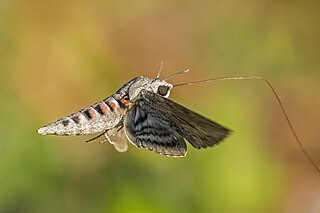
Agrius convolvuli, the convolvulus hawk-moth, is a large hawk-moth. It is common throughout Europe, Asia, Africa, Australia and New Zealand, partly as a migrant. In New Zealand, it is also known as the kumara moth, and in the Māori language as hīhue.

The AN/PVS-14 Monocular Night Vision Device (MNVD) is in widespread use by the United States Armed Forces as well as NATO allies around the world. It uses a third generation image intensifier tube, and is primarily manufactured by Litton Industries and Elbit Systems of America. It is often used 'hands free' using a head harness or attached to a combat helmet such as the PASGT, MICH TC-2000 Combat Helmet, Advanced Combat Helmet, Marine Lightweight Helmet or IHPS. It can also be used as a weapons night sight. In addition, it was part of the equipment fielded in the U.S. Army's Land Warrior program. Morovision Night Vision was the law enforcement distributor of the NEPVS-14 for ITT.
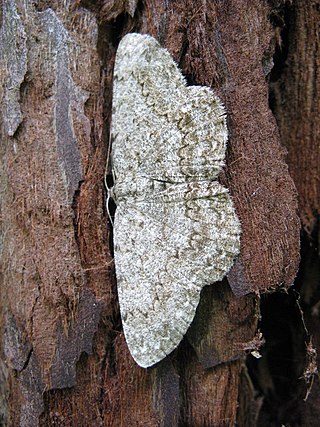
The Boarmiini are a large tribe of geometer moths in the Ennominae subfamily.

Harpella forficella is a species of the concealer moth family (Oecophoridae), wherein it belongs to subfamily Oecophorinae.
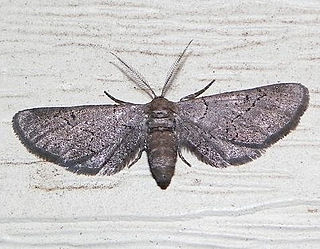
Exelis is a genus of moths in the family Geometridae erected by Achille Guenée in 1857.

Blastobasis glandulella is a species of moth of the family Blastobasidae. It is found in the Eastern United States and southern Ontario, Canada. It has also been recorded in California. In Europe, it has been recorded from Austria, Germany, the Czech Republic, Italy, Slovakia and Croatia.
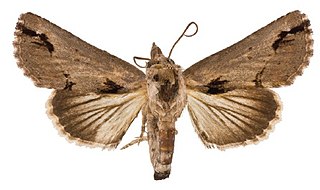
Paectes nana is a moth in the family Euteliidae. It is widespread from Florida through the Greater Antilles and from Mexico to Costa Rica. In South America, it is found in Venezuela, Colombia and northern Ecuador. It has been introduced to the Galapagos Islands.
Accuminulia buscki is a species of moth of the family Tortricidae described by John W. Brown in 2000. It is found in Chile. The species was first recorded as an interception at the Port of New York in a shipment of grapes from Chile.
Sorhagenia baucidis is a moth in the family Cosmopterigidae. It was described by Ronald W. Hodges in 1969. It is found in North America, where it has been recorded from Illinois and Saskatchewan.
Neargyractis slossonalis, the dimorphic leafcutter moth, is a moth in the family Crambidae. It was described by Harrison Gray Dyar Jr. in 1906. It is found in Cuba and the south-eastern United States, where it has been recorded from Alabama, Florida, South Carolina, Georgia and Mississippi.
Petrophila schaefferalis is a moth in the family Crambidae. It was described by Harrison Gray Dyar Jr. in 1906. It is found in Mexico (Xalapa) and the southern United States, where it has been recorded from Arizona, California and Texas.

Acleris maculidorsana, the stained-back leafroller moth, is a species of moth of the family Tortricidae. It is found in North America, where it has been recorded from Arkansas, Florida, Georgia, Kentucky, Maine, Maryland, Massachusetts, Michigan, Mississippi, New Jersey, North Carolina, Ohio, Ontario, Pennsylvania, South Carolina, Tennessee, Virginia and Wisconsin.
Eudonia expallidalis is a moth in the family Crambidae. It was described by Harrison Gray Dyar Jr. in 1906. It is found in North America, where it has been recorded from Washington to Nevada and California.
Eudonia schwarzalis is a moth in the family Crambidae. It was described by Harrison Gray Dyar Jr. in 1906. It is found in North America, where it has been recorded from Arizona.

Arugisa lutea, the common arugisa moth, is a species of moth in the family Erebidae. The species was first described by John B. Smith in 1900. It is found in the United States, where it has been recorded from Maryland and Virginia to Florida, west to Texas and Missouri.
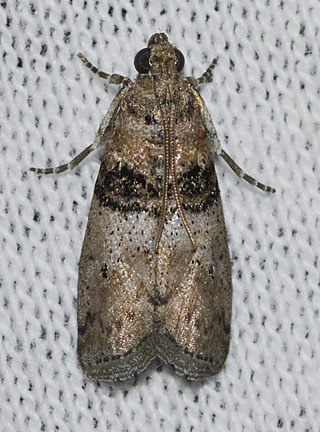
Tlascala is a monotypic snout moth genus described by George Duryea Hulst in 1890. Its only species is Tlascala reductella, the Tlascala moth, described by Francis Walker in 1863. It is found in North America, where it has been recorded from Florida to Illinois and Kentucky, as well as in Ontario. It has also been recorded from Honduras.
Keiferia glochinella, the eggplant leafminer moth, is a moth in the family Gelechiidae. It was described by Zeller in 1873. It is found in the United States, where it has been recorded from Texas, New Mexico and California. Records outside the western United States are based on misidentifications.
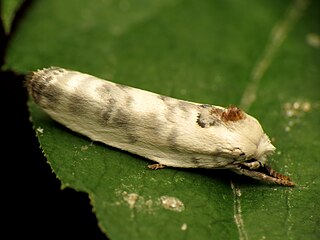
Antaeotricha leucillana, the pale gray bird-dropping moth, is a moth in the family Depressariidae. It was described by Philipp Christoph Zeller in 1854. It is found in North America, where it has been recorded from New Hampshire, Massachusetts, New York, Pennsylvania, District of Columbia, Virginia, North Carolina, Georgia, Alabama, Arkansas, Missouri, Kansas, Illinois, Iowa, Texas, Oregon, Louisiana, Manitoba and Nova Scotia.

Glena cognataria, the blueberry gray moth, is a moth native to North America. It ranges from Florida to Nova Scotia and New Brunswick. Its larvae is hosted on blueberry. The habitat consists of bogs and pine barrens. It is listed as a species of special concern and believed extirpated in the US state of Connecticut.
Exelis ophiurus is a species of geometrid moth in the family Geometridae. It is found in North America.












